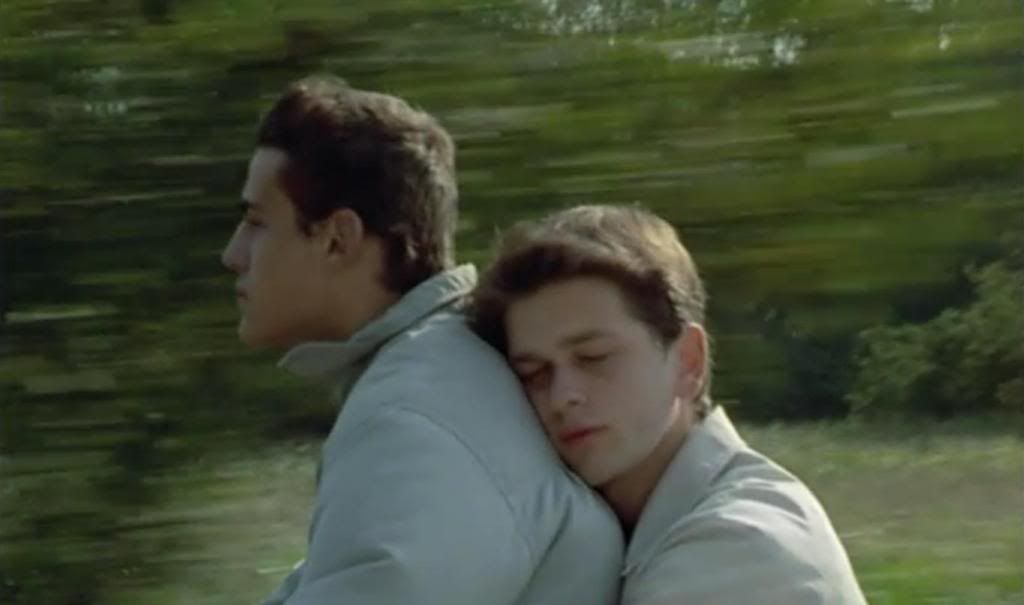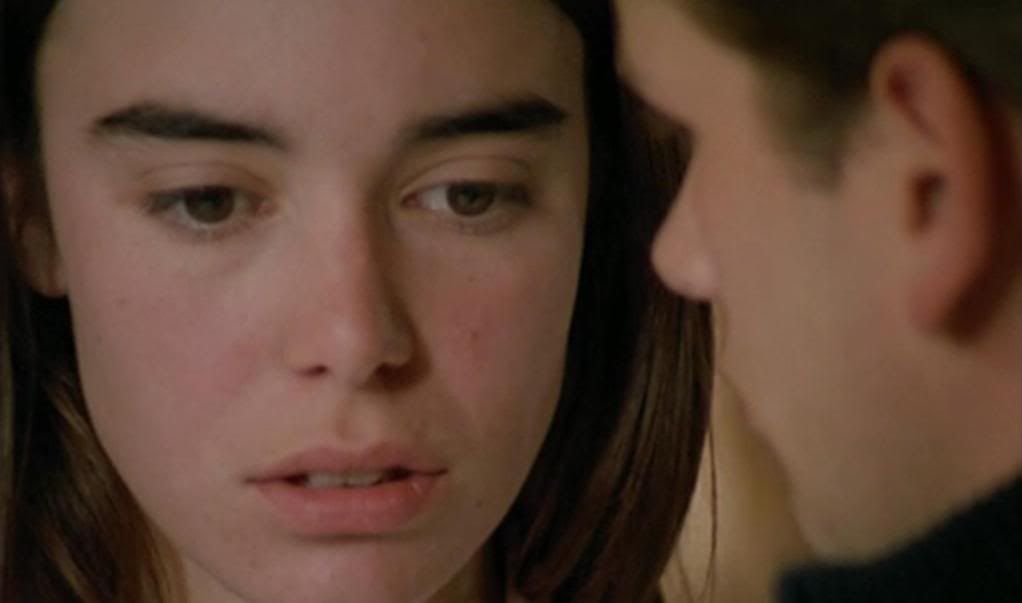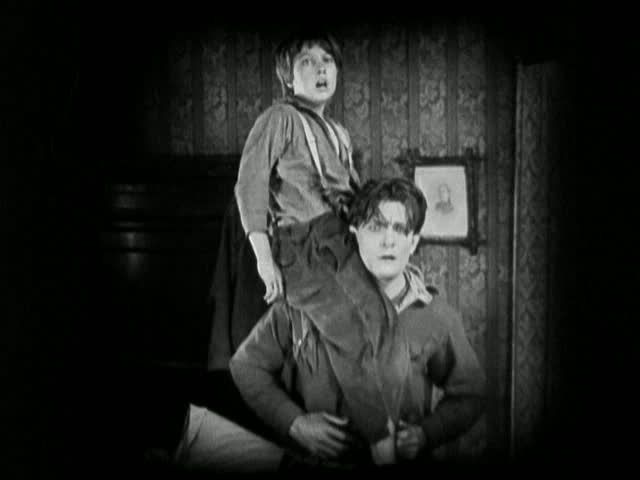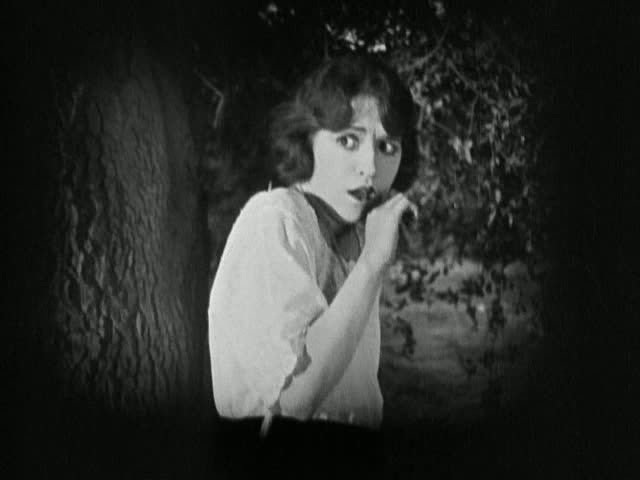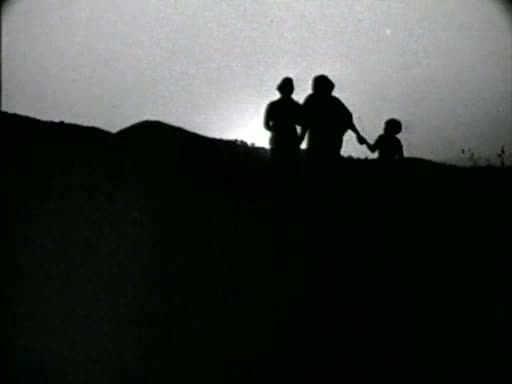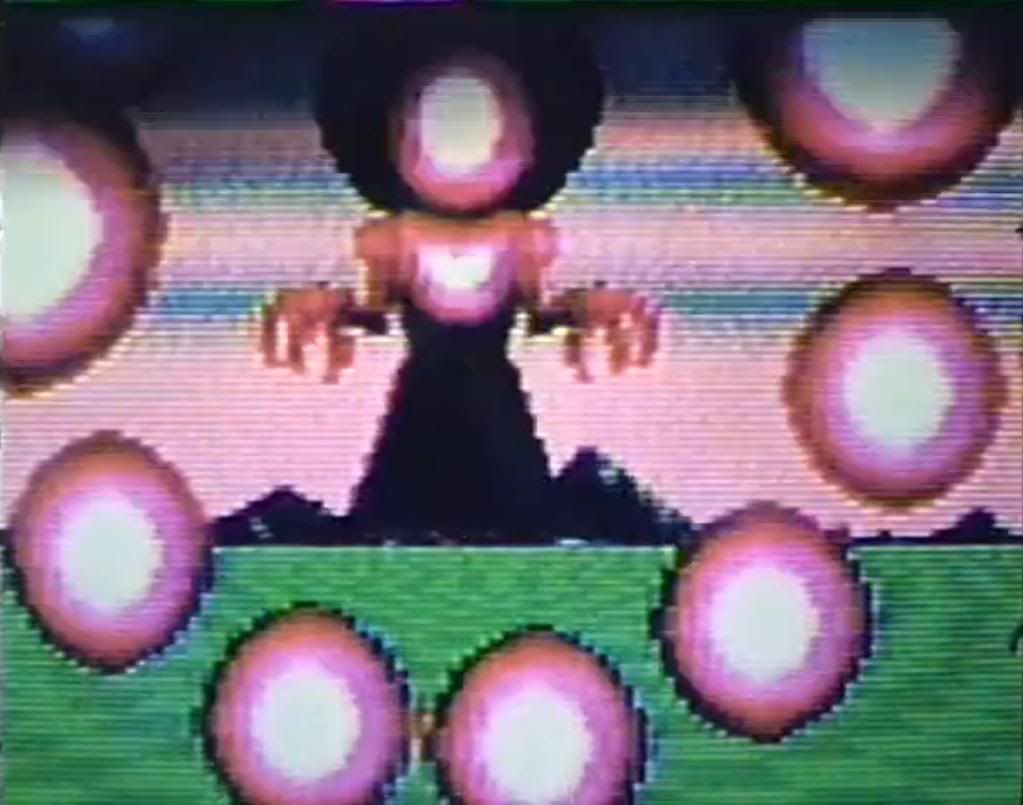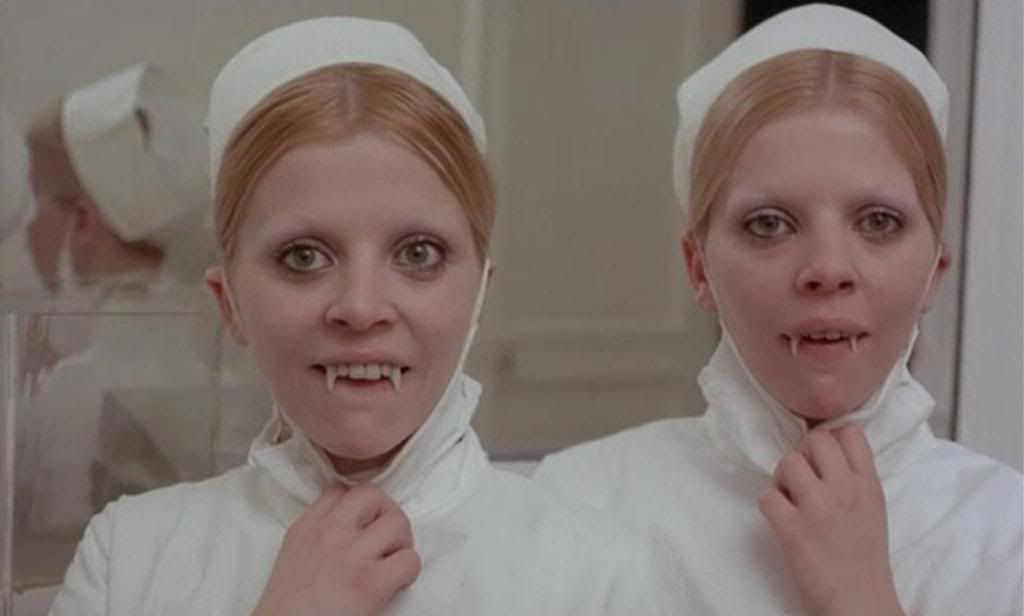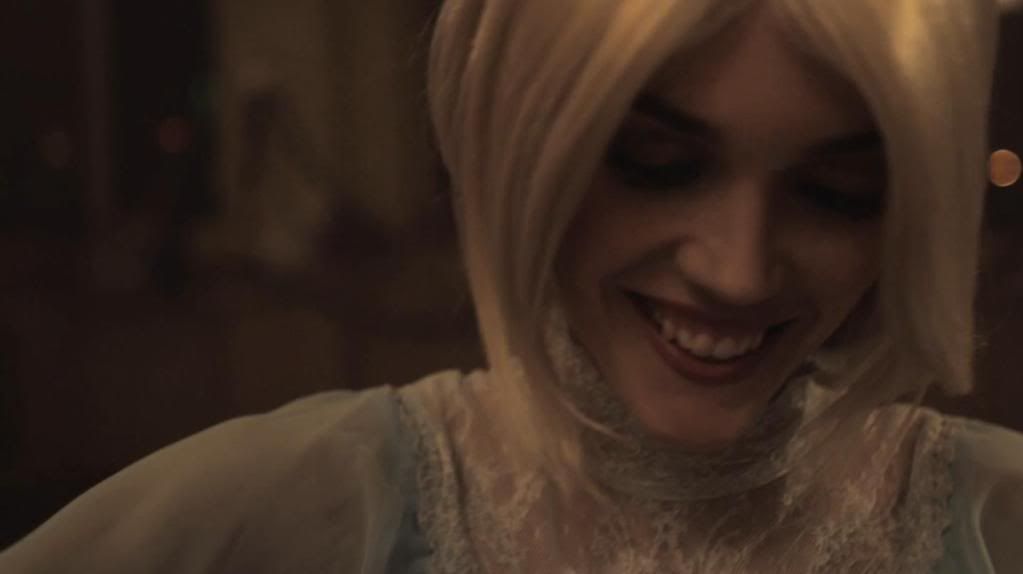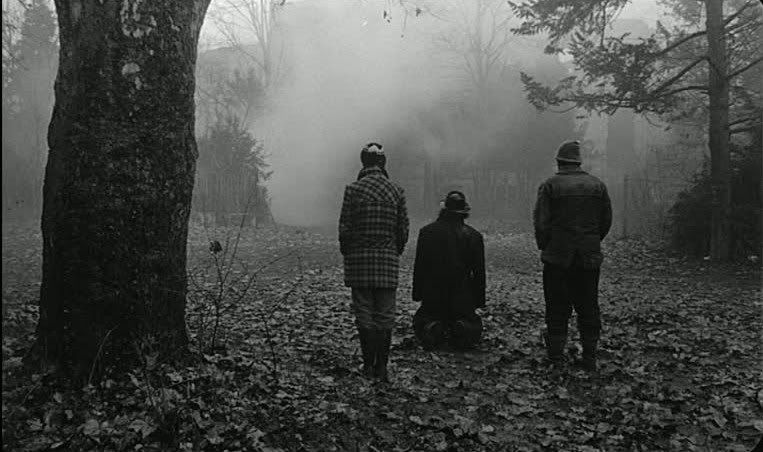Following Monday's
2012 in film list, here is my top 25 for the year in music. These lists are incomplete every year but it feels especially so this year, when I had less time than ever to listen to all the music I wanted to hear. Still, here are 25 great albums from 2012.
 1. Lil B | God's Father (Based World)
1. Lil B | God's Father (Based World)
2012 was the year of Lil B. At least for me it was. There was no artist I listened to more this year, and no artist who excited, baffled and provoked me so consistently. The young rapper first caught my attention last year, with
I'm Gay (I'm Happy), a mixtape that turned heads with its controversy-baiting promotion but maintained interest with a cohesive string of moody, introspective songs that had little to do with that flamboyant title. That dichotomy is a good indication of what's in store with Lil B: irresolvable tension between earnest positivity, crass rap clichés, and aggressive confrontation of those same clichés. From album to album or song to song, Lil B might be a wide-eyed nature-lover, a rude sex-obsessed misogynist, a philosopher of positivity, a gangsta, or a loony surrealist who insists that he looks like Ellen Degeneres, Miley Cyrus and Bill Clinton. There's little trace of the goofy extremes of that latter mode on
God's Father, but otherwise the many sides of B are well-represented here — and how could they not be, on a mixtape that stretches to 34 tracks, for nearly two full hours of based listening?
That's a lot of Lil B, but he's always been an artist who's as concerned with quantity as quality, and this year he's been especially active, releasing 17 mixtapes totaling over 21 hours of music — and that's not even counting an 855-song data dump that overlapped with previous releases but still contained over 8 hours of new and previously uncollected music. In that context, a two-hour mixtape isn't really excessive, especially since this one is remarkably consistent, packed with one great track after another. It's a two-hour album of nothing but highlights from a rapper who has often been characterized elsewhere by his scattershot inconsistency and lack of a filter.
Much of the album finds B in his most accessible and direct mode, delivering earnest philosophical musings and slice-of-life stories over cloud-rap ambience and soul samples, but what makes
God's Father so great, what marks it out as the best Lil B release in a year packed with gems from the prolific rapper, is its ability to encompass so many of the different aspects of this complicated, fragmentary figure. As "Real Hip Hop 2012" makes clear with its sincere and well-realized Wu-Tang homage, Lil B is above all a dedicated historian of rap music, and he's able to absorb much of the genre's history and its multitude of conflicting sensibilities, making each of them his own and placing them side by side. Hence the naked aggression and nuttiness of "I Own Swag" — which jacks a David Banner beat and takes swipes at the older rapper, climaxing with the joyously exclaimed, "that's what you shoulda done on this beat, motherfucker!" — can share space with tracks like the lovely "Flowers Rise," which samples video game music, or nostalgic coming-up stories with glistening, silvery beats, like "Secrete Obsession" and "SF Mission Music." It's an expansive vision, one that refuses to commit to any one sound or set of concerns but, here at least, also never comes across as schizophrenic or ADD-afflicted. Lil B's massive output and barrage of Twitter/Facebook promotion suggests the fragmentation and increased speed of Internet culture, but musically, he's anything but blinded by the now. Instead, he's constantly looking forward to an imagined utopian future where everyone's "based," while musically namedropping everyone from Wu-Tang to Three 6 Mafia to Jay-Z, always keeping an eye on his forebears as well as his contemporaries.
Lil B had a great and very busy year; it would've been possible to fill the entire top 10 of this list with his albums and still have a few gems left over. In fact, in tribute to his amazing year, this list is followed by a Lil B-only top 10. Those other mixtapes are great, too, ranging from the 90s-style party rap of
#1 Bitch to the schizoid eclecticism of
White Flame to the nutty and purposefully dumb
Task Force to the cloud-rap street tales of
Glassface and the delightfully named
Obama BasedGod. But it's
God's Father I keep returning to as Lil B's finest accomplishment to date, the best possible summary of a figure who otherwise resists easy summary. The real genius of Lil B is in the sprawl, which means that it's better to listen to five or six or ten Lil B albums than one, but if one album can possibly be picked out of the overall patchwork of the hours and hours of music he's released this year,
God's Father is the one.
 2. Wreck and Reference |
2. Wreck and Reference | Youth [No Youth] (Flenser)
This remarkable duo's uniquely skewed approach to black metal first appeared on last year's grimy, Bandcamp-released
Black Cassette, which cleverly combined digital-age cutting-edge with outdated technologies and a bleak, sullen sound awash in noise. With their second album, the duo have cleared away some of the murk —
Black Cassette was purposefully muddied-up by transferring between digital and analog media — but maintained the bleak atmospherics. There are no guitars on either Wreck and Reference album, only drums and electronics, but they churn up their processed, distorted walls of samples and synth lines into monolithic riffs and strummed notes that resonate into the void. The music is intense and emotionally raw, with vocals alternating between melodic chanting — sometimes tweaked with electronics into splintered, high-pitched tones — and growly metal screaming. The drums provide a grounding in "real" metal playing, with rapid fills and constant shifts in tempo, while the layered electronics vacillate between creating industrial-metal drones and approximating guitar shredding. It's a powerful and unforgettable record that takes a decidedly non-traditional approach to metal orthodoxy, interspersing its more explosive moments with droney, moody passages, muttered monologues, and stretches of melodic singing that sound like religious exultations.
 3. Swans | The Seer (Young God)
3. Swans | The Seer (Young God)
Michael Gira's return to the Swans, the seminal post-punk outfit he led until their late 90s breakup, has been one of the great musical pleasures of recent years. The reformed Swans have picked up right where they left off, crafting gloomy, epic drone-rock that's made to be played as loud as possible; music meant to overwhelm, to bludgeon, to pound the listener into a state of blissful, ecstatic immersion in which the music is everywhere, everything, impossible to escape. The band's triumphant return,
My Father Will Guide Me Up a Rope To the Sky, was relatively straightforward, a set of thrashing, pummelling rock songs driven by the pulsing repetition of the drone and by Gira's alternately enraged and resigned baritone vocals.
The Seer takes things much further, focusing on the droning, almost ritualistic aspects of the band's music. It's a huge, epic double-disc set, with songs that just keep building and building with no end in sight: the title track is a solid half-hour of relentless cyclical riffing with chanted vocals, and the second disc is dominated by two twenty-minute slabs of noisy catharsis. Gira has surrounded himself with likeminded guests, whose presence mainly adds to the communal ritual vibe given off by the music: Alan Sparhawk and Mimi Parker from Low chant along with Gira on opener "Lunacy," while elsewhere he's joined by his former collaborator Jarboe and his protégés Akron/Family. This is
big music, obsessed with apocalypse, with creation and destruction, with violence and the occult.
 4. Jason Lescalleet | Songs About Nothing (ErstSolo)
4. Jason Lescalleet | Songs About Nothing (ErstSolo)
For his first proper solo album since 2006's intensely personal
The Pilgrim, tape-loop sound artist Jason Lescalleet has crafted his finest statement yet, a double album that encompasses the full range of his music and his unique ideas about sound, influence, and sampling. It's a story of multiple reference points, musical touchstones that are miles apart in terms of sound, ideology, and scenes, and yet here are married within Lescalleet's expansive sound world. Lescalleet is drawing on Steve Albini's industrial/post-punk provocateurs Big Black — from whose 1987 disc
Songs About Fucking Lescalleet has drawn this album's title, its clever cover, and its track lengths — as well as Depeche Mode and "You're No Good," Terry Riley's fantastic tape deconstruction of a Harvey Averne R&B tune. The first disc of Lescalleet's album is divided into thirteen consise, punchy tracks, the same number of songs as appeared on the LP version of
Songs About Fucking. The music is comprised of sizzling high-pitched electronics, field recordings and snippets of voices conversing, and, notably, sampled guitar riffs that are looped and layered into massive walls of noise. It's Lescalleet's version of a punk album, although one where the guitars appear only sporadically and briefly, usually before being radically altered or swallowed up by hungry waves of electronic noise. The second disc, on the other hand, consists of a single 43-minute piece, and it's more abstract than the first, without the obvious guitar samples, consisting of lengthy drones and stretches of hushed near-silence in which a fire crackles and a train rumbles by. It's an album of punk followed by an album of high-art
musique concrète composition, and it's on the latter disc that Lescalleet inserts some samples from the noisy second half of "You're No Good," electronic swoops the source of which will be obvious to anyone who's heard the Riley piece. The disc then closes with a slowed-down segment of Depeche Mode that's mostly allowed to stand on its own. The Riley insert is especially notable as something of a punk gesture, with Lescalleet dropping a piece of another composer's music into his own, distorting and manipulating sounds which were themselves the result of distorting and manipulating pop music. Lescalleet is completing the cycle, and by doing so, not only is he creating a work that is in itself beautiful, provocative and intense, but he's bridging the gap between the punky snarl of Albini and Big Black, the playful minimalism of Riley, and the downbeat pop of Averne and Depeche Mode. It's a complex and challenging record, its reference points clear but its real beauty deriving not from those sources and inspirations but from the ways in which Lescalleet builds his own ideas, his own statements, around and upon the music he's referencing.
 5. Pedestrian Deposit | Kithless (Arbor)
5. Pedestrian Deposit | Kithless (Arbor)
Until 2006, Pedestrian Deposit was the solo noise project of Jon Borges, whose dense, intricate walls of harsh noise were some of the most blistering and powerful on the scene. But Borges took that sound as far as it would go, and when PD re-emerged after a hiatus in 2009, Borges had been joined by cellist Shannon Kennedy, and the new duo version of Pedestrian Deposit proceeded to craft an entirely new and exciting music very distinct from the abrasive noise of Borges' earlier work. On the duo's latest album, and their first on vinyl, this evolution has reached its peak. It's a gorgeous diptych on which the noise textures of Borges' early years have been all but entirely abraded away, replaced by the keening scrape of Kennedy's cello, at times entirely unaugmented, or else swallowed up and processed by electronics, warped into elongated drones. The album opens with mournful cello tones echoing into a void, with a faint suggestion of hissing static filling in the silences between notes. The cello is soon joined by small scraping and rustling noises, bits of close-mic'd noise that skitter around underfoot, worrying at the sweet, sad serenity of the strings. The music is aching and melancholy: "kithless" is an antiquated word for being without friends or family, kinless, and Borges and Kennedy assiduously evoke this loneliness and isolation through their music. At one point, the cello drones are supplanted by a long sequence of heavy breathing and sighing, an outgrowth of the duo's stage performances, in which Kennedy submerges herself in freezing cold water and records her shivery, whispery breath. That moment of raw emotion and physicality provides important context for the duo's music, which is now at its most subtle and minimalist but still contains a kernel of the intensity that once defined Borges' solo music.
 6. Scott Walker | Bish Bosch (4AD)
6. Scott Walker | Bish Bosch (4AD)
Scott Walker's latest discharge is a wild and chaotic and fearlessly obscure album that follows 1995's
Tilt and 2006's
The Drift as the third installment in this one-time pop star's reinvention as a Brechtian avant-garde provocateur. Walker's last opus took over a decade to complete, while this one follows
The Drift after a comparatively brief six-year span, and indeed it's a much looser and loopier album than either of its predecessors. It's apparent from early on that Walker's vicious sense of humor has come to the fore here, when on "Corps de Blah" the archly delivered line "the sphincter's tooting a tune" unleashes a chorus of actual farts, lovingly recorded and as carefully crafted as any of the more traditionally produced sounds Walker is working with here. The album's sound is eclectic and jarring. At times, Walker's baroque voice floats out of an eerie void, moaning and crooning, leaving pregnant pauses in which listeners can wrestle uncomfortably with his often-confrontational and puzzling lyrics. Elsewhere, there are bursts of pseudo-industrial rhythms, grating electronics, jazzy finger snaps, bleeting horns that recall the earlier fart sounds, big metal riffs that stutter along for a few moments before cutting off in favor of more silence or some orchestral bombast or, on "Phrasing," a few passages of sunny bossa nova. All of this and more is especially encapsulated on the album's mammoth centerpiece, the 22-minute "SDSS1416+13B (Zercon, A Flagpole Sitter)." Here, Walker really stretches out, arranging bursts of frenzied noise around long stretches where his aching vocals float unaccompanied, delivering bizarrely unfunny jokes like "you're so fat/ when you wear a yellow raincoat/ people scream 'taxi'." There's a lot of nastiness here, with Walker often taking on the persona of a lousy insult comic, or else musing on death, decay, aging, nagging mothers, and ungrateful children. The album's lyrical darkness, encompassed in both elaborate mazes of imagery and direct statements of anger and hate, is matched by the alternating bombast and minimalism of Walker's arrangements. Even when the music verges on incomprehensibility, which it frequently does, there are moments of bleak beauty and striking verbal images that pull the listener irresistably into Walker's insular, outlandish world. This is a thrilling and unforgettable album; there's nothing else in music like a new Scott Walker album, nothing as daring, as unafraid to face ridicule and charges of pretension, as utterly strange and funny and scary and confounding.
 7. Mount Eerie | Clear Moon/Ocean Roar (P.W. Elverum & Sun)
7. Mount Eerie | Clear Moon/Ocean Roar (P.W. Elverum & Sun)
Phil Elverum of Mount Eerie has taken his time following up the explosive, black metal-inspired
Wind's Poem — one of his very best albums — but the pair of albums he released this year have validated the three-year wait. Elverum hasn't entirely retreated from the moody metal drones and abrasive textures of
Wind's Poem, which at the time represented the apotheosis of a direction the always-evolving songwriter had been moving in for several years. Instead, he's maintained the intensity and atmosphere of that music while largely toning down the distortion, and has subtly incorporated electronics as a new element in his ever-expanding palette. It's a music of subtleties, where every detail matters: when, on "Clear Moon," Elverum's voice is unexpectedly autotuned for a few bars, it's exhilarating and oddly beautiful, a moment of wonderful restraint with an electronic tool that's often slathered liberally over slick pop records. It's more than the novelty of finding such devices within the universe of Elverum's insular bedroom rock; it's the fact that Elverum has taken these electronic flourishes and incorporated them so thoroughly into his sound that the electronics, mostly manifested as bits of drum machine programming and subtle sound processing, feel like just another element in the landscape. The usual interstitial bits of noise that always appear on Elverum's albums have here been transformed into glistening, crystalline synth drones that conjure images of a frozen wilderness, the icy ground unbroken by footprints. Similar icy synths weave through songs like the lovely "Lone Bell," with its skittering undercurrent of drums and bold synthesized horn lines punctuating the beautiful melancholy of Elverum's vision. These records frequently recall ambient music, with Elverum's plaintive murmur barely making it above the droney electronics or the hazy metal riffs that have been slowed down and smeared into a fog of distortion. The overall impression of this music is indistinct, blurry, chilly, a music of arctic cold, the music of vapors arising from the snow in the morning sun. It's not as immediate as the best moments of
Wind's Poem, especially on
Ocean Roar, which is even hazier and moodier than
Clear Moon, all shoegaze guitars and extended buildups to a release that never quite comes. This subtle music requires careful attention, and even then it keeps its sense of mystery very much intact.
 8. Aesop Rock | Skelethon (Rhymesayers)
8. Aesop Rock | Skelethon (Rhymesayers)
Aesop Rock kind of disappeared over the years. The Def Jux MC was big with backpackers and fans of twisty abstraction in the early years of the new millennium, the perfect time for his paranoid, frenzied aesthetic and, since I was in college when his classic
Labor Days dropped, the perfect time for me in particular to get caught up in his dense, wordy mazes of rhyme. But he followed up
Labor Days with the disappointing, largely self-produced
Bazooka Tooth, and though subsequent albums were better, he quickly faded from view.
Skelethon is his first full-length album since 2007, and it's a triumphant return to form. It's again self-produced, but Aesop's production has made a quantum leap from the busy but lifeless thump-thump-thump of
Bazooka Tooth; this album's sound is intense and aggressive, with drums that leap and skitter crazily, shards of guitar winding between the breakneck beats, rubbery basslines with a funky propulsiveness. Finally, Aesop's music has caught up to his breathless lyrical delivery, and the result is exhilarating and exhausting. The huge drum sound drives forward some of the rapper's best rhymes ever, as he pours out a non-stop barrage of words, often overwhelming the listener with so many complex metaphors, obscure references and odd images that deciphering any meaning from this chaos seems like a lost cause. Gradually, though, meaning emerges, and the album's themes slowly become apparent: childhood rebellion, the importance of music as symbol and social signifier, and, especially, death. "ZZZ Top" spins out a tale of three different kids using music — Led Zep, Afrika Bambaataa, and Mexican-American punks the Zeros — as symbols of their developing identities. Later, "Racing Stripes" hilariously relates what seem to be childhood memories of kids rebelling with their haircuts, and "Grace" finds Aesop improbably taking on the persona of a mom trying to cajole and mock her son into eating his green beans. In the context of the album as a whole, this nostalgia for childhood's petty rebellions and uncertainty about identity seems like a response to the adult world's far more serious problems. In particular, Aesop seems haunted by the death of a friend, at one point wondering about the distinctly modern form of grieving that is obsessing over a dead friend's name and number in a cell phone. This thread reaches its apex on the fantastic "Crows 1," in which Aesop tries to force his own form of mourning onto his friend's death, refusing — through surrogate Kimya Dawson, who sings the morbid hook — to deal with a decaying body in a casket, preferring the more abstract treatment of ashes scattered in the ocean or under a tree. It's a potent and poignant album, with these kinds of emotional revelations hidden everywhere within the music's dense labyrinths of words and drums.
 9. Liars | WIXIW (Mute)
9. Liars | WIXIW (Mute)
Liars have always been a band who resisted easy pigeonholing or categorization. While they debuted with a couple of albums that were (perhaps too) comfortably slotted into the dance-punk revival of the early 2000s, since then they've evolved into a much stranger and more unsettling beast. If at first they seemed content to perform able repetitions of their post-punk forebears, they later evolved into one of the great experimental rock bands of the last decade, combining jittery aggression with tribal drums, vocal chants, moody ambiance, and unpredictable song structures.
WIXIW continues this path of experimentation; sonically, it's the least characteristic Liars album, but because of that, it may just be the
most characteristic of the band's inventive restlessness. Here, the trio's rock instrumentation is largely subsumed by electronic textures: droning atmospherics, bits and pieces of 80s-ish synth-pop, the glistening, crystalline ambient music of Brian Eno. Despite the radical stylistic shift, the band's character is very much intact, creating an overriding mood of dread and despair within these minimalist electronic structures. Some reference points are hard to escape — Tangerine Dream and other Krautrock electronic pioneers, Wire's 1980s reinvention as a gloomy synth-pop outfit, Radiohead circa
Kid A — but the haunting quality of the music and the unsettling leaps from one track to the next belong wholly to the Liars. The title track is a perfect example, with Angus Andrew breathily intoning "I wish you were here with me" over a bed of driving percussion, the drums buried deep in the mix beneath a wheezing organ-like motif, its cyclical motion subverting the forward drive of those distant drums. It's as though the band has decided to sabotage the one element that had previously remained constant throughout all its various transformations, its emphasis on rhythm and drums. The drums remain primarily as a looping, subliminal pulse, felt more than heard, and the result is the loosest-sounding Liars album yet, despite its heavily worked-over electronics and layered compositions. It's gorgeous, sad, and sinister, and may just be their finest accomplishment yet.
 10. Killer Mike | R.A.P. Music (Williams Street)
10. Killer Mike | R.A.P. Music (Williams Street)
Killer Mike makes a breakthrough with the sharpest, most focused and intense statement of his career, a gritty and soulful album of high-octane rap, loaded with bold lyrical assaults and backed by the dense production of Def Jux founder El-P. The album's sound, courtesy of El-P, is dark and foreboding, noisy and mean, and Mike rises to the occasion with a fiery delivery and a lyrical focus on the politics of drugs, the ghetto, and race in America. The album's centerpiece is "Reagan," a paranoid polemic laced with snippets of Reagan's contradictory statements on the Iran Contra scandal. Mike's first verse castigates rappers, including himself, for glamorizing the thug lifestyle for the kids who listen to their music, then shifts gears to run through a series of political conspiracy theories, even taking aim at Obama for being just another "talking head speaking lies on teleprompter," and climaxing with the insinuation that Reagan was actually the Anti-Christ. It's bold, frenzied stuff, and Mike follows it up with the even more incendiary "Don't Die," which traces out a revenge fantasy against the kind of corrupt, racist cops who killed Black Panther Fred Hampton. There's more nuance in the haunting, melancholy "Anywhere But Here," which compares white-run New York with its billionaire mayor to black-run Atlanta and concludes that neither city is really addressing the pervasive problems of poverty and education.
R.A.P. Music ends with the gorgeous title track, which compares rap to religious music — Mike clearly cares very deeply about his music, its meaning and its impact, and that seriousness is evident throughout this album. This is overtly polemical music of the kind that isn't fashionable anymore, but which was one of the foundations of rap's history. Mike, along with El-P, draws on the example of Public Enemy and N.W.A. to deliver an intense, confrontational record bursting with anger, vitality, and raw emotion.
 11. Lower Plenty | Hard Rubbish (Easter Bilby/Special Award)
11. Lower Plenty | Hard Rubbish (Easter Bilby/Special Award)
Something of a supergroup of Australian garage rockers, this trio's ramshackle lo-fi folk is very distant from the churning fuzz of the bands (like UV Race and Total Control) from which they emerged. Tentative acoustic guitars are backed by plodding drums that sound like they're being played from another room, with bits of ambience and field recordings drifting in and out of the mix as though onlookers are lazily meandering through the recording space, oblivious to the band. All three band members sing, their voices sometimes alternating for verses or whole songs, sometimes overlaying one another in unstudied pileups as though they're all just huddled around a campfire, tunelessly crooning along to the rudimentary strumming and the lazy beats. The monotone moans of Al Montfort and Jensen Thjung contrast sharply against Sarah Heyward's slightly sweeter tones. When electric guitar appears, as it does on "Dirty Flowers," it hardly seems to be playing notes at all, just laying down a current of rumbling distortion against which Heyward's lilting couplets struggle to stay afloat. The songs are simple and rough, with a purity and a sense of place that makes them especially evocative — songs like the lovely "Nullarbor" are intimately rooted in Australian geography, and even for those not familiar with the places named, the images of stolen cars, long-distance drives and old flings are concrete and potent. This is stripped-down, raw music, its emotions largely understated and resigned — a sigh rather than a scream — but extremely powerful in its restraint and simplicity.
 12. Dirty Projectors | Swing Lo Magellan (Domino)
12. Dirty Projectors | Swing Lo Magellan (Domino)
Conventional wisdom about this album is that, now that Dirty Projectors frontman and sole constant Dave Longstreth has stripped down his music to a relatively accessible, minimalist pop foundation, without as many of the wild structural detours and eccentrically elaborate arrangements of previous albums, he's finally "emotional." That's nonsense, not because
Swing Lo Magellan isn't an emotionally affecting record, but because this isn't a new quality in Longstreth's music; for all the off-beat time signatures and twisty song structures that have often characterized the Dirty Projectors, a core of raw feeling has always remained at the center of their music, embodied by Longstreth's cracking, straining voice and the smoother female voices with which he offsets his own oddball croon. Here, those voices carry even more of the burden than ever before, because
Swing Lo Magellan is a comparatively simple album, musically; the explosive guitars have largely been calmed, and the songs are far more direct than ever before, laying bare the slightly warped but very appealing pop sensibility that has always driven even the band's strangest music. On "About To Die," Longstreth sings a mildly morbid love ballad over plucked, rubbery guitars, drums that sound like bouncing tennis balls, and the cooing hums of Amber Coffman and Haley Dekle. This is immediately followed by "Gun Has No Trigger," which sounds like a typical Dirty Projectors song hollowed out, stripped down to a steady hip-hop beat and vaguely sinister background humming as Longstreth belts out a melancholy hymn about failure and empty rebellion. Much of the album's effect comes from the grit in Longstreth's voice, the way he often seems to be straining, audibly taking breaths to prepare for a particularly intense passage, his voice filling with emotion on the evocative "Just From Chevron," which bookends Longstreth's fiery middle section with calmer balladry from the women in the group. This album may represent a more accessible and direct side of this band, especially on the folksy title track and the lovely closer "Irresponsible Tune," but in its emotional intensity and its emphasis on vocal virtuosity,
Swing Lo Magellan is very much building on the band's past work while consciously refusing to simply repeat their past successes.
 13. Kevin Drumm | Relief (Mego)
13. Kevin Drumm | Relief (Mego)
In recent years, at least on his more high-profile works, Chicago noise legend Kevin Drumm has tended more towards synthesizer drones and slow, creeping ambience, as epitomized by the languid
Imperial Horizon and
Imperial Distortion. His newest LP,
Relief, doesn't entirely abandon this direction, but integrates it into a noisy, churning palette that recalls
Sheer Hellish Miasma — which was, perhaps not coincidentally, Drumm's last album on Mego and one of the towering landmarks of the last decade in noise. On
Relief, the drones of the "Imperial" albums are retained as stable centers amidst the roiling noise that surrounds them. There's a throughline of low-key, melodic synthesizer music running through the album, barely heard through the fog of static and screeching high-frequency tones. This submerged melodicism gives the album a vaguely spiritual aura, as the churchy, haunting synth tones emerge from the murk and grime as almost a subliminal presence, a subtle suggestion of order and beauty within a generally cold and cruel world. The music is not nearly as fierce as
Miasma, and the catharsis isn't as intense;
Relief is more deliberate, a harsh but carefully modulated record on which its noisy grit is always balanced by the underlying loveliness of those tranquil melodies. It's the work of a musician who's consolidating all of his strengths in one place, incorporating his recent experimentation with the successes of his earlier years, recalling all of this history without seeming like he's merely repeating himself.
 14. Julia Holter | Ekstasis (Rvng Intl.)
14. Julia Holter | Ekstasis (Rvng Intl.)
On
Tragedy, Julia Holter's debut full-length from last year, a little slice of vocoder-driven synth-pop called "Goddess Eyes" seemed just slightly out-of-place amidst that record's eclectic mix of neo-classical experimentation, noisy electronics, field recordings and occasional bursts of avant-pop songs. On
Ekstasis, two more versions of "Goddess Eyes" make an appearance, but here the whole record seems to have been structured around them. Holter's tamed the schizophrenic sprawl of her debut and honed in on a single direction out of the multitude she'd explored over the course of her first album. At first, this seems like a step back — the mad ambition and creative splintering of
Tragedy was a big part of its appeal — but
Ekstasis is just a very different type of record, and in its own way might even be better than its predecessor. Holter's voice here croons and echoes as if in a cathedral, set against a backdrop of gorgeous synthesizer pieces that are by turns bright and burbling, moody and low-key, dense and foreboding. This is a set of remarkable synth-pop tunes, crafted with not a trace of obvious nostalgia; unlike so much of today's knowingly retro synthesizer-driven music, this doesn't seem to be calling out the music of the past so much as crafting a thoroughly modern take on a form that is generally linked with a particular time — and those who want to evoke that time. Holter harmonizes with her own disembodied and echoing voice, while layering synth motifs that are simple in form but deeply resonant in their emotions. In this context, "Goddess Eyes" no longer feels like one more diversion on an album defined by its eclecticism. Here, the song's haunting romanticism and glistening melodies are perfectly suited to the album's uniform mood of slightly distanced, icily perfect beauty.
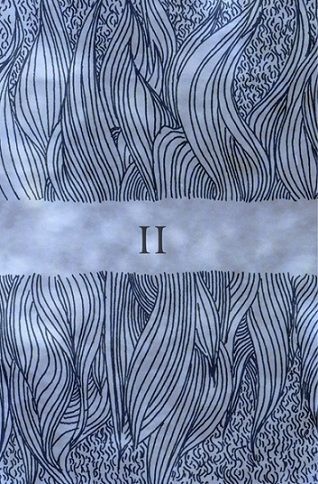 15. Voder Deth Squad | II (SicSic)
15. Voder Deth Squad | II (SicSic)
The second tape from Jeremy Kelly and M. Geddes Gengras is every bit as good as their first, creating the same vibe of spacey, vaguely sinister ambient synthesizer music. This is real UFO music, a perfect soundtrack for long trips through wormholes or staring at the flashing lights from the end of
2001: A Space Odyssey. The music slowly, patiently unfurls itself across each of these side-long twenty-minute pieces, with languid synth melodies reverberating through the vacuum. The duo leave plenty of space; the tape is never really silent but the synth lines are allowed to naturally decay, hinting at the void that might come roaring in if the music ever entirely trailed off. Instead, the burbling, pulsing electronics inevitably cycle right back up again before that can ever happen, and these central lines are surrounded by swirling alien noises and bleeping. The effect is hypnotic and haunting, as the music gradually builds from a sparse and grim foundation to lush layers of melody and back again.
 16. Biota | Cape Flyaway (ReR)
16. Biota | Cape Flyaway (ReR)
The latest album from this long-running experimental collective arrives five years after their last effort, which found the group settling a bit too comfortably into their by-now familiar heavily processed textural soup, in which fragments of too many instruments to name are swirled together into a dense pastiche of ethnic musics, fractured pop, folk, progressive rock, and droney electronics. This time around, all the familiar Biota elements are still in place, but the group has conceived a set of songs structured around the influence of English folk, and the subtle changes this triggers in their music are palpable and very welcome. Singer Kristianne Gale returns from the last Biota album (breaking a streak of guest vocalists sticking around for only one album ever since the band started incorporating vocals in the mid-90s) and contributes lilting, haunting ballads that evoke and sometimes quote from classic English folk tunes. Her sad, high tones appear sporadically throughout the album, acting as its central presence even when she hangs back and lets the music speak for itself. The juxtaposition of these melancholy melodies with the group's jangly guitars, organ drones and warped drums makes for an intriguing combination, rendering these classic motifs somewhat strange and new due to the context.
 17. Clams Casino | Instrumental Mixtape 2 (no label)
17. Clams Casino | Instrumental Mixtape 2 (no label)
Clams Casino returns with his second album of beats, and where this kind of collection often feels like an indulgence, a novelty, from other hip-hop producers, with Clams it's absolutely essential. While his combination of shoegazer melodies, booming drums and fuzzy, hissy atmospherics makes a perfectly enveloping blanket for any rapper, and while Clams made his name backing up Lil B, his music really seems to thrive when the vocals are stripped away and his aesthetic is allowed to stand on its own. This glistening, soulful music, with its wordless, chopped-up vocal harmonies and dense production, sounds great behind a rapper but seems to really blossom when there's no one to talk over it, when every reverberating drum and crackling background noise becomes the focus rather than lyrics or rhymes. This year, Clams propped up rappers like A$AP Rocky and Mac Miller, but these tracks sound much better here, with a grace and a mysterious beauty that's not always that well-served by the rappers Clams works with the most. But even the tracks that were great to begin with — like a couple from the Main Attrakionz crew or Lil B's breakthrough classic "I'm God," at last appearing as a proper instrumental track — are very welcome presences here, showcasing just how exciting these productions are, and just how comprehensive Clams' aesthetic is. Even when he remixes tracks from artists as diverse as Washed Out and Lana Del Rey, he effortlessly makes these songs his own as well.
 18. Vatican Shadow | September Cell (Bed of Nails)
18. Vatican Shadow | September Cell (Bed of Nails)
Dominick Fernow continues to be extraordinarily prolific with his dark ambient project Vatican Shadow, which has increasingly absorbed more of his attention than his previously dominant Prurient alias. The flood of limited tapes and vinyl that Fernow has crafted under this name only increased this year, but the quantity of new material hasn't diminished the overall impression of this body of work as one of the most vital in modern noise music.
September Cell only represents one facet of that work, a vinyl EP that does about as good a job as any other Vatican Shadow record at capturing the project's eerie appeal. It's stripped-down, minimalist techno that seethes with barely contained emotion, building tremendous tension from the elemental combination of pulsing beats with keening synth melodies. The sound is by now familiar to anyone who's been following this new direction in Fernow's music — and its antecedents in the synth and noise scenes of the past are very clear as well — but the potency of these recordings has not faded one bit since Vatican Shadow's debut.
 19. Rangda | Formerly Extinct (Drag City)
19. Rangda | Formerly Extinct (Drag City)
I can't say I ever expected a second album from this modern psych supergroup, but I'm really glad it's here. Rangda is the ferocious power trio of Sun City Girls' Richard Bishop, Six Organs of Admittance's Ben Chasny, and ubiquitous improv/psych-rock drummer Chris Corsano.
Formerly Exinct easily tops their 2010 debut
False Flag, which now feels like merely a warmup for the intense instrumental workouts that the trio have unleashed this time around. It's exactly the kind of music one expects from a band consisting of two modern guitar gods and a virtuoso drummer: tightly wound, intricate, prone to flights of high-octane soloing from both guitarists. But this is no mere display of technical prowess, and the trio's raw instrumental talent is always channelled into music that has as much feeling and fire as it does virtuosity. Chasny and Bishop are both fascinated by Indian music and other non-Western sources, and these influences frequently show up here, buried in fuzz and distortion, alongside more traditional classic rock reference points: the gorgeous, melodic guitar solo that emerges in the second half of "The Vault" recalls Neil Young at his best. All three musicians are as comfortable with this kind of straightforward rock jamming as they are with the more meandering, spacious, Eastern-influenced "Silver Nile," which immediately follows "The Vault." Chasny and Bishop's guitar styles are complementary enough that they intertwine easily, but distinct enough that the individual voices are still apparent in these serpentine entanglements of riffs. Noisy, dense and varied,
Formerly Extinct is an ideal team-up for these exciting instrumentalists.
 20. Burial | Kindred (Hyperdub)
20. Burial | Kindred (Hyperdub)
The UK dubstep producer Burial has always been wary of expectations and acclaim — he remained anonymous until his identity was uncovered by a newspaper in 2008 — so his refusal to follow up 2007's
Untrue with a third full-length feels like a way of dodging expectations, of subverting the widespread and semi-mainstream adoration that greeted his first two albums. Since 2007, he's been only sporadically active, collaborating on vinyl-only EPs with Four Tet, Thom Yorke and Massive Attack, and in the last couple of years starting to re-emerge with some solo singles as well. These discs, including
Kindred, find the producer's sound largely unchanged: gauzy, reverb-encrusted slabs of sound with loose, flitty beats, throbbing bass, and vocal samples smeared until they sound like ghosts haunting these tracks, singing in a language that vaguely recalls English but where meaning and individual words can be elusive. There's something about his music that makes a new track feel instantly familiar: on the first spin, cuts like "Kindred" and "Ashtray Wasp" worm into one's brain so stealthily that it already feels like the tenth spin, or the hundredth. On the title track, the bass pulses, thick and sinister, and the drums skip across the surface of the music, light as air, while a female voice coos and slurs, occasionally delivering a more intelligible snippet: "baby you can find the light." The central track, "Loner," opts for more of a hard club groove with a pulsing, menacing synth line, but it's "Ashtray Wasp" that's the real standout here, gradually building up a driving rhythm while distorted, disembodied voices moan, "I want you... I need you... I belong."
 21. Aluk Todolo | Occult Rock (The Ajna Offensive)
21. Aluk Todolo | Occult Rock (The Ajna Offensive)
This third album from these French metalheads — all veterans of the black metal scene who have largely, but not entirely, left the strict tenets of that genre behind — expands their vision into a towering, monolithic mass of dark, foreboding sound. The trio stretch out across this sprawling double album, effortlessly crafting 10-minute-plus epics in which metal riffs are hammered into the rambling, build/release/build structures of millennial post-rock. The music has more in common with Mogwai or certain strains of Krautrock than it does black metal. This integration of post-rock's restraint and structural concerns into a doomy metal aesthetic has been a trend in recent years but Aluk Todolo take it to the extreme; there are times on "IV" that they hearken all the way back to Slint with some circular, repeating guitar figures emerging from the general morass of distortion, backed as always by the nimble drums of Antoine Hadjioannou, the band's subtle backbone. The overall effect is hypnotic and lulling, with wave after wave of guitar fuzz and deep bass pulsations washing over the unwary listener.
 22. Of Montreal | Paralytic Stalks (Polyvinyl)
22. Of Montreal | Paralytic Stalks (Polyvinyl)
Of Montreal's reinvention from a twee-pop Elephant 6 offshoot into surprisingly funky, eclectic purveyors of fractured pop collages is by now well-established enough that this sound threatens to become overly familiar and safe. Kevin Barnes has shaken things up in recent years by splintering his music more and more, delivering divisive records like
Skeletal Lamping and
False Priest that flit wildly from one idea to the next at a frantic pace.
Paralytic Stalks steps back from this trend to offer yet another variation on the group's subtle evolution, this time honing in on the noisy, dissonant chaos that has always lurked at the edges of Barnes' music. Here, "We Will Commit Wolf Murder" morphs by its end from a typically jaunty Of Montreal pop tune into a dark, dense soup of beats and noise, then segues effortlessly into the sunny woodwinds of "Malefic Dowery," the one throwback here to a simpler and sweeter era of Barnes' music. After that, the album leaps off a cliff with the nine-minute sprawl of "Ye Renew the Plaintiff," which melds psych-rock hysteria with the relentlessly bouncy forward motion of the beat and all kinds of noise swirling around in the mix. This all still sounds very much like Of Montreal, and there are still enough musical ideas and sounds jammed into each song to sustain most other artists for an album or two, but it's Of Montreal with a slightly different emphasis, a new twist on the insular mental landscape that Barnes has been elaborating on since around 2004.
 23. Spitta Andretti x Harry Fraud | Cigarette Boats (no label)
23. Spitta Andretti x Harry Fraud | Cigarette Boats (no label)
On this compact web-released EP, rapper Curren$y collaborates with producer Harry Fraud, and the result is one of Spitta's most focused and enjoyable sets. It helps that it's exceptionally tight: just 5 songs, around 15 minutes total, with two short guest appearances by MCs (Styles P and Smoke Dza) who fit in perfectly with Curren$y's languid celebration of the "jet life." Harry Fraud's lush, sensuous productions — all swooning, hazy samples, a gauzy choir of female voices, slowly pulsing beats — is also a perfect complement to the rapper, whose subject matter and style are by this point well-established. It's all about how great his life is, basically, how much better his weed is than anyone else's, how much hotter his girls are, how many cars and houses and fancy clothes he owns. It's bragging honed into an art, and it's a lot of fun to listen to — in small doses, anyway, which is why this super-short set may just be the most enjoyable Curren$y has ever been. His laidback delivery is all in service to thinking up new and clever ways to rhapsodize about his lifestyle, even if much of it has to be bullshit: the final track, "Sixty-Seven Turbo Jet," proves that Curren$y's either a terrible criminal or a total poser, since in the process of praising his "getaway car" and his house he lays out all his plans for dealing with cops and details exactly where he hides his money and his drugs. Regardless, it's great that this EP is so detailed, that Curren$y's braggadocio is never generic, and Harry Fraud provides a perfectly luxurious backdrop for these tossed-off but well-constructed verses. This is the sound of a great rapper settling comfortably into the perfect sound like it's an expensive leather armchair.
 24. Godspeed You! Black Emperor | 'Allelujah! Don't Bend! Ascend! (Constellation)
24. Godspeed You! Black Emperor | 'Allelujah! Don't Bend! Ascend! (Constellation)
I'm as surprised as anyone to find a Godspeed You! Black Emperor album on a 2012 best music list. Before this year, the post-rock legends hadn't released an album since 2002, focusing instead on various side bands and other projects in the intervening decade, and their epic, apocalyptic music, with its rise/fall structures and found-sound samples, began to seem like a thing of the past, intimately linked with millennial angst. Instead, the band has re-emerged after reforming for live shows in recent years, and this new album seamlessly picks up their trajectory, feeling in every way like the fourth album they might have recorded as a stellar comeback soon after 2002's relatively disappointing
Yanqui U.X.O. In fact, the album's two lengthy twenty-minute slabs of rock — which are broken up by a pair of shorter drone tracks — are re-titled versions of songs that had appeared in the band's live performances shortly before their decade-long hiatus commenced. The band's sound is very much intact: epic swells of guitar-led orchestral rock, with a busy rhythm section buttressing up the layers of distortion, passages of squealing melodicism, dramatically sawing strings, fiery soloing. "Mladic" builds its squalls around a vaguely Middle Eastern melody, played in a high register on one guitar among the many that constitute the song's dense construction. As always, the band's music is divided into loose movements, with passages of barrelling rock giving way to maudlin minor-key interludes, the music swelling and ebbing, a pattern that had already started to feel formulaic by the group's third album but now, after a decade away, is a welcome reminder of what made their first two records so exciting when they were new.
 25. The Mountain Goats | Transcendental Youth (Merge)
25. The Mountain Goats | Transcendental Youth (Merge)
At this point, a new album from John Darnielle is a comforting pleasure. The incendiary emotional bombast of Darnielle's earlier recordings, back when the Mountain Goats were just him, a guitar and a hissy boombox, has long since been tamed and reshaped, funneled into the more expansive, more polished vision of Darnielle's latter-day recordings with a full rock band. The music has changed, sacrificing raw immediacy for greater complexity and musical nuance, and it's a tradeoff that's sometimes for the better, sometimes not. But one thing that hasn't changed is the quality of Darnielle's songwriting, his ability to quickly and economically sketch out a verbal image or delineate the entirety of a life and a character with a few well-chosen words. His great albums and his merely good albums (there's no other kind) alike are full of evidence of Darnielle's brilliance as a storyteller and portraitist.
Transcendental Youth is, to be honest, one of the merely good ones; it lacks the focused intensity of something like
The Sunset Tree, and though it's a thematic/stylistic grab bag like last year's great
All Eternals Deck, it lacks that album's experimentation and forcefulness. What it does have is one good song after another, one patiently drawn character study leading into the next, Darnielle's voice mostly avoiding the cracking, straining quality of his rawest outbursts, instead delivering these eloquent short stories with deadpan understatement. A few songs have horn arrangements, which aren't as revelatory or jaw-dropping as
All Eternals Deck's flirtation with barber-shop harmonies, but still provide some sonic diversity to Darnielle's tight, stripped-down music. The horns blurt ecstatically on the closing title track, providing bursts of bright, beautiful light in between the sweet sadness of the verses. On the record's best song, "The Diaz Brothers," a jaunty piano line winds through this propulsive rocker, as Darnielle sings in an exuberant tone about murder, betrayal and criminality, weaving a poignant tale out of a pair of incidental characters from the movie
Scarface.
And now, some honorable mentions and, as promised, a Lil B 2012 top 10.
Honorable Mentions: Cut Hands, Jason Crumer, El-P, Guillemots, Tim Hecker & Daniel Lopatin, Jel x Main Attrakionz x Zachg, Mouse On Mars, Michael Pisaro & Toshiya Tsunoda, Pete Swanson, Sun Kil Moon, THEESatisfaction, Vasculae, Yeasayer, Richard Youngs
Lil B Top 10
1. God's Father (February)
2. Obama BasedGod (July)
3. White Flame (January)
4. #1 Bitch (March)
5. Glassface (December)
6. Rich After Taxes (July)
7. Illusions of Grandeur 2 (October)
8. Task Force (July)
9. The Basedprint II (April)
10. Water Is D.M.G. Pt. 1 (May)
